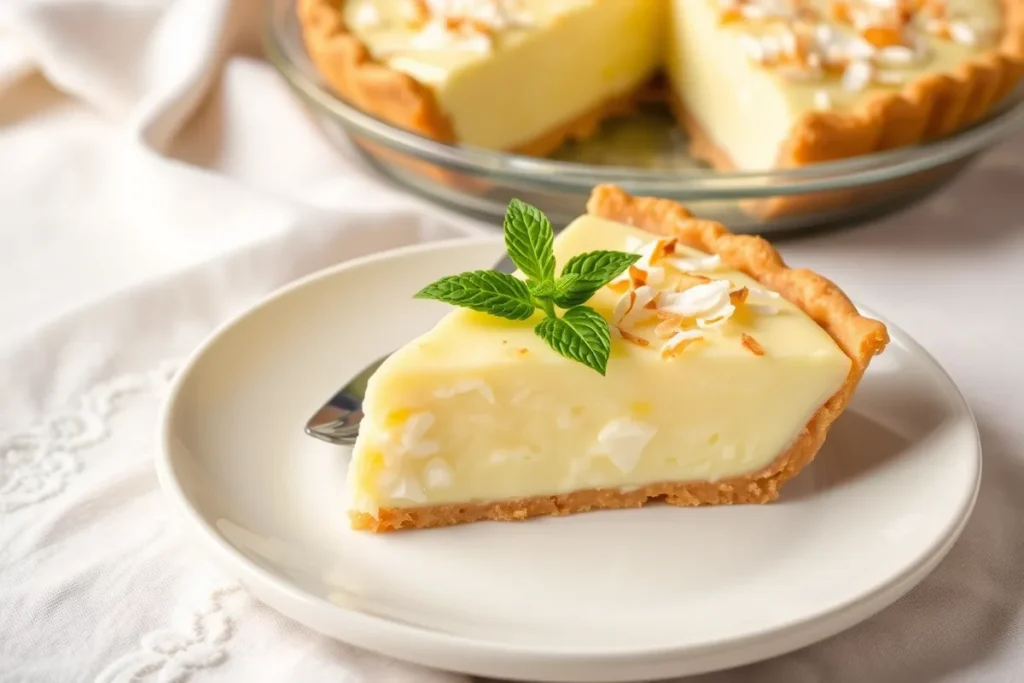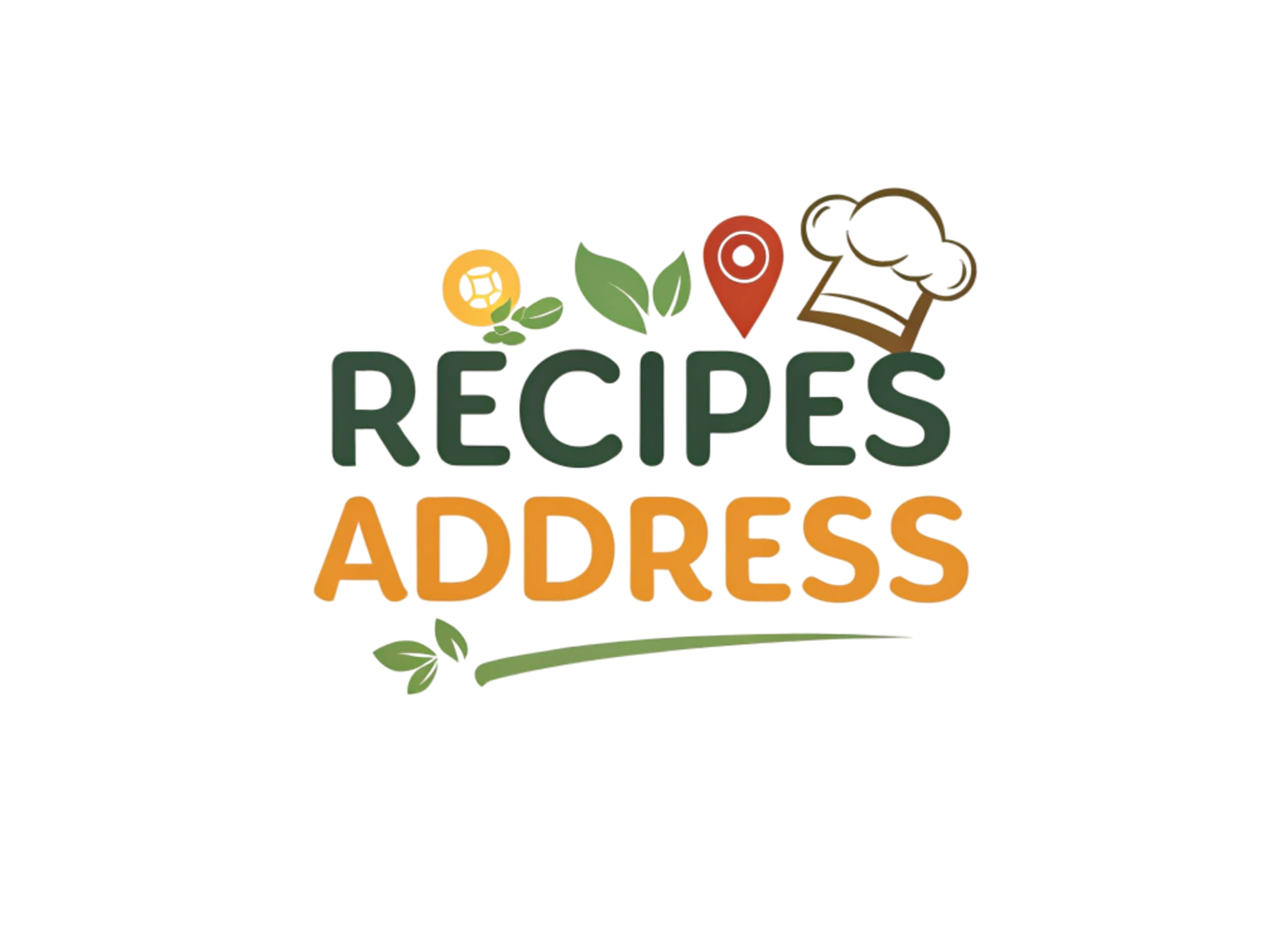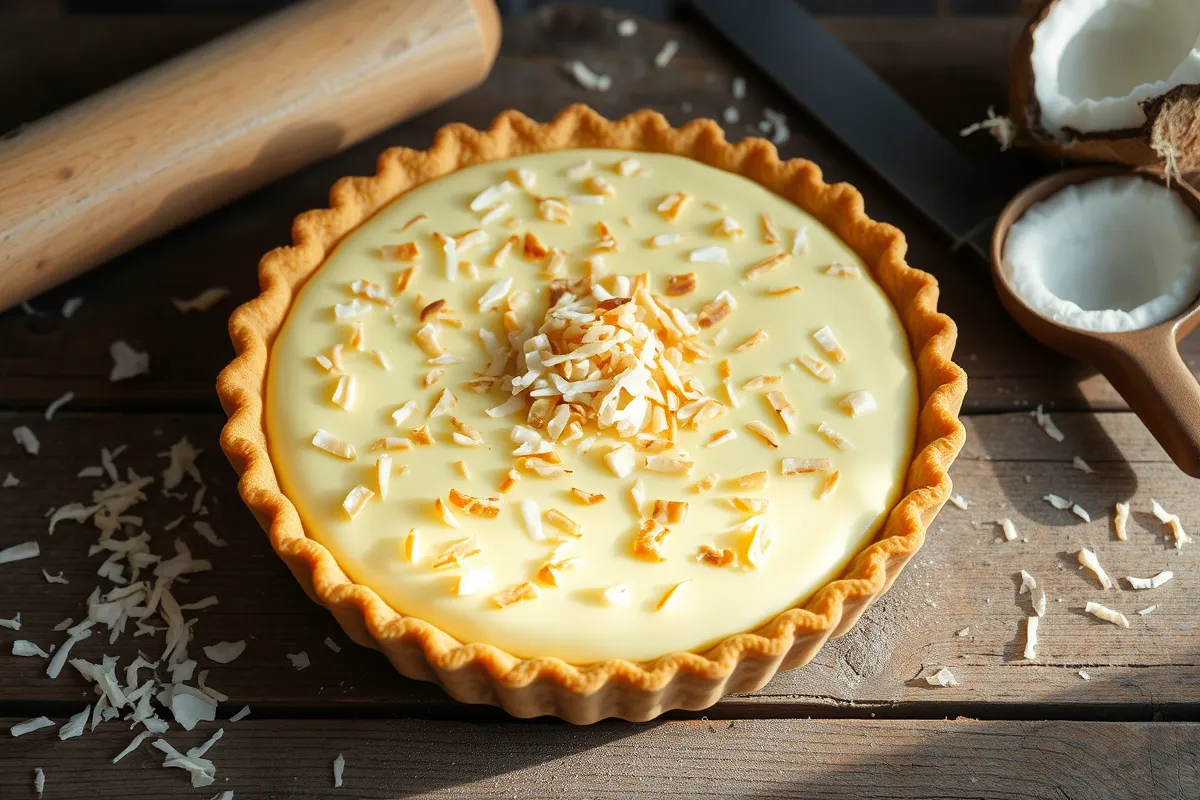Introduction
Coconut custard pie is a timeless dessert that combines a rich, creamy custard with the tropical flavor of coconut. Loved by families across generations, this delightful treat is perfect for any occasion, from casual family dinners to festive celebrations. The smooth custard filling, complemented by a flaky pie crust, creates a dessert that is both satisfying and indulgent.
Not only is a coconut custard pie incredibly delicious, but it is also surprisingly easy to make. Whether you are a seasoned baker or just starting in the kitchen, this recipe will guide you through creating a pie that everyone will adore. In this article, we will dive into the essentials of crafting the perfect pie, explore variations, and share tips to ensure success every time.
What is Coconut Custard Pie
Coconut custard pie is a classic dessert that features a smooth, creamy filling made from a mixture of milk, eggs, sugar, and shredded coconut. This filling is baked in a buttery pie crust until it sets into a custard-like consistency. The result is a pie that combines a silky texture with the subtle sweetness of coconut, making it a favorite for dessert lovers.
Unlike its close cousin, the coconut cream pie, coconut custard pie is baked with the filling, allowing the custard to cook and set in the oven. In contrast, coconut cream pie involves a cooked filling that is poured into a prebaked crust and topped with whipped cream. This distinction gives coconut custard pie its unique texture and flavor profile, ideal for those who enjoy a more traditional, homestyle dessert.
Throughout history, coconut custard pie has been a cherished recipe in many households, often appearing on holiday tables and special gatherings. Its appeal lies in its simplicity, versatility, and ability to bring comfort with every bite. Whether served warm or chilled, this dessert is a celebration of the humble yet flavorful coconut.
Ingredients Needed for The Coconut Custard Pie Recipe
Creating a delicious coconut custard pie begins with gathering the right ingredients. Each component plays a crucial role in achieving the perfect flavor and texture. Here’s a detailed look at what you’ll need:
Essential Ingredients for the Pie
- Pie crust: A buttery, flaky crust is the foundation of this dessert. You can use a store-bought crust for convenience or prepare a homemade version for added freshness.
- Shredded coconut: Choose unsweetened shredded coconut for a balanced sweetness, though sweetened coconut can be used for a richer flavor.
- Eggs: Essential for creating the custard, eggs provide structure and richness.
- Milk or cream: Whole milk or heavy cream works best to create a smooth, creamy custard. For a lighter option, you can substitute with coconut milk to enhance the coconut flavor.
- Granulated sugar: Adds sweetness to the custard without overpowering the delicate coconut taste.
- Vanilla extract: A touch of vanilla enhances the custard’s overall flavor.
- Nutmeg or cinnamon (optional): A sprinkle of these spices can add a warm, aromatic touch to the pie.
Tips for Selecting Quality Ingredients
- Coconut: Opt for fresh shredded coconut or high-quality packaged coconut to ensure the best flavor. Avoid brands with added preservatives or artificial flavors.
- Dairy: Use full-fat milk or cream for a custard that is rich and creamy. Skim milk may result in a thinner texture.
- Eggs: Fresh, large eggs are essential for creating a smooth and cohesive custard.
With these ingredients on hand, you’re well on your way to baking an irresistible coconut custard pie.
Step-by-Step Recipe Guide for The Coconut Custard Pie Recipe
Preparing the Crust
A good crust is the cornerstone of a successful coconut custard pie. Whether you choose to make it from scratch or use a store-bought option, the crust should be buttery and flaky.
- Homemade Crust Option:
- Combine 1 ¼ cups of all-purpose flour, ½ teaspoon of salt, and 1 tablespoon of sugar in a bowl.
- Cut in ½ cup of cold, unsalted butter using a pastry cutter or your fingers until the mixture resembles coarse crumbs.
- Gradually add 3–4 tablespoons of ice water, mixing until the dough just comes together.
- Roll out the dough on a floured surface, then transfer it to a pie pan. Trim the edges and crimp as desired. Chill for at least 30 minutes.
- Store-Bought Crust Option:
- Use a high-quality refrigerated pie crust. Allow it to come to room temperature, then fit it into your pie pan and crimp the edges.
Making the Custard Filling
The custard filling is the heart of the coconut custard pie. Achieving the perfect balance of flavors and consistency is key.
- Mix the Ingredients:
- In a large bowl, whisk together 3 large eggs, 1 cup of granulated sugar, and 1 teaspoon of vanilla extract until well combined.
- Gradually stir in 1 ½ cups of whole milk or coconut milk and 1 cup of shredded coconut. If desired, add a pinch of nutmeg or cinnamon for extra warmth.
- Check the Consistency:
- The mixture should be smooth and free of lumps. Strain through a fine-mesh sieve if needed to ensure a silky custard.
Assembling and Baking
- Combine the Crust and Filling:
- Pour the custard mixture into the prepared pie crust, spreading it evenly.
- Sprinkle an additional tablespoon of shredded coconut on top for a decorative touch.
- Bake the Pie:
- Preheat your oven to 350°F (175°C). Place the pie on the center rack and bake for 45–55 minutes, or until the custard is set but still slightly jiggly in the center.
- To prevent overbrowning, cover the edges of the crust with aluminum foil halfway through baking.
Cooling and Serving

- Cool the Pie:
- Allow the pie to cool completely on a wire rack. This step is crucial for the custard to set properly.
- Serve and Enjoy:
- Slice and serve at room temperature or chilled. For added indulgence, top with whipped cream or a sprinkle of toasted coconut.
Tips and Tricks for the Perfect Coconut Custard Pie
Creating a flawless coconut custard pie can be simple with the right techniques. These tips and tricks will help you avoid common pitfalls and elevate your dessert to the next level.
Avoiding Common Mistakes
- Prevent a Soggy Crust:
- Blind bake the crust before adding the custard. To do this, line the crust with parchment paper, fill it with pie weights or dried beans, and bake for 10–15 minutes at 375°F (190°C). This ensures the crust stays crisp even after baking with the filling.
- Achieve a Smooth Custard:
- Strain the custard mixture through a fine-mesh sieve to eliminate any lumps or egg solids.
- Control Browning:
- Keep an eye on the edges of the crust. If they brown too quickly, cover them with aluminum foil or a pie shield.
Learn more about blind baking and perfecting pie crusts.
Enhancing Flavor and Texture
- Toast the Coconut:
- Toast the shredded coconut before adding it to the filling or as a garnish. This step enhances its natural sweetness and adds a nutty aroma.
- Add a Splash of Coconut Extract:
- For a bolder coconut flavor, include ¼ teaspoon of coconut extract in the custard mixture.
- Incorporate a Hint of Citrus:
- A teaspoon of lemon or lime zest can add a refreshing brightness to the pie.
Storage and Reheating
- Proper Storage:
- Store leftover coconut custard pie in the refrigerator, covered with plastic wrap or aluminum foil. It will stay fresh for up to 3 days.
- Reheating Tips:
- To serve warm, gently reheat individual slices in the microwave for 15–20 seconds. Be cautious not to overheat, as the custard may curdle.
Mastering these tips will ensure your coconut custard pie turns out perfectly every time, impressing everyone who takes a bite.
Variations of Coconut Custard Pie
Coconut custard pie is a versatile dessert that can be customized to suit different tastes and dietary needs. Here are some creative variations to try:
Adding Chocolate or Other Flavors
- Chocolate Coconut Custard Pie:
- Add a layer of melted dark or semi-sweet chocolate to the bottom of the crust before pouring in the custard. This creates a decadent twist with a rich, chocolatey surprise.
- Tropical Flavors:
- Incorporate tropical fruits like pineapple or mango into the custard for a fruity variation. Dice the fruit finely and fold it into the mixture before baking.
- Spiced Coconut Custard Pie:
- Enhance the custard with warm spices such as cardamom, cloves, or allspice for a cozy, aromatic flavor profile.
Dietary Modifications
- Gluten-Free Option:
- Use a gluten-free pie crust made from almond flour or a combination of rice and tapioca flours. Ensure all ingredients used are certified gluten-free.
- Dairy-Free Option:
- Replace the milk or cream with coconut milk or almond milk, and use dairy-free margarine or coconut oil for the crust.
- Vegan Coconut Custard Pie:
- Substitute eggs with a vegan egg replacer or a mixture of cornstarch and water. Use plant-based milk and a vegan crust for a completely animal-free version.
Regional Twists and Presentations
- French Coconut Custard Tart:
- Use a tart pan and a thinner layer of custard to create an elegant, French-inspired version of the pie. Top with toasted coconut for a decorative finish.
- Mini Coconut Custard Pies:
- Bake the custard in small tartlet shells or ramekins for individual servings, perfect for parties or gatherings.
- Caramel-Topped Coconut Pie:
- Drizzle caramel sauce over the baked pie before serving for an indulgent touch.
With these variations, you can adapt the classic coconut custard pie to match your personal preferences or dietary needs while still enjoying its signature creamy texture and coconut flavor.
Health Considerations for The Coconut Custard Pie Recipe
Coconut custard pie is undeniably delicious, but it’s also important to consider its nutritional profile. While it can be enjoyed as an occasional treat, here are some points to keep in mind about its health aspects:
Nutritional Information
- Caloric Content:
- A standard slice of coconut custard pie typically contains around 300–400 calories, depending on the recipe and portion size. Ingredients like cream, sugar, and eggs contribute to its richness.
- Macronutrients:
- The pie is high in fats, with a significant portion coming from eggs, coconut, and dairy. It also contains moderate amounts of carbohydrates from sugar and the crust, along with a small amount of protein from the eggs and milk.
- Micronutrients:
- Coconut provides some essential nutrients, including iron, manganese, and dietary fiber, especially if using unsweetened shredded coconut.
Moderation and Portion Control
- Enjoy in Small Portions:
- Due to its richness, a small slice can be satisfying. Pairing it with a lighter main meal can help balance the overall calorie intake.
- Opt for Healthier Versions:
- Consider using alternatives like low-fat milk, less sugar, or a crust made with whole-grain flour to slightly reduce calories and increase fiber content.
Possible Allergens
- Common Allergens:
- Coconut: While rare, some individuals may have a coconut allergy and should avoid this pie.
- Eggs and Dairy: These are essential ingredients in traditional recipes, making the pie unsuitable for those with allergies unless adapted.
- Gluten: If a standard pie crust is used, it will contain gluten. Opt for a gluten-free crust to accommodate dietary restrictions.
While coconut custard pie isn’t a low-calorie dessert, it can still be a part of a balanced diet when enjoyed occasionally and in moderation. By making small tweaks, you can tailor the recipe to fit specific dietary needs.
Frequently Asked Questions about Coconut Custard Pie Recipe
How is coconut custard pie different from coconut cream pie?
Coconut custard pie is baked with the custard filling, allowing the eggs to cook and set in the oven. In contrast, coconut cream pie features a cooked custard or pudding filling that is poured into a prebaked crust and topped with whipped cream. The key difference lies in the texture and preparation method.
Can I use sweetened coconut instead of unsweetened?
Yes, you can use sweetened coconut, but it will make the pie sweeter. To balance the flavors, consider reducing the amount of sugar in the custard filling. Unsweetened coconut is recommended if you prefer a more subtle sweetness.
How do I prevent the crust from becoming soggy?
To avoid a soggy crust, blind bake the pie crust before adding the custard filling. This technique creates a barrier that helps the crust stay crisp during baking. Additionally, ensure the filling is not too runny by following the recipe measurements closely.
What’s the best way to store leftover pie?
Store any leftover coconut custard pie in the refrigerator. Cover it tightly with plastic wrap or aluminum foil to keep it fresh. The pie can be stored for up to three days, but it’s best enjoyed within the first two days for optimal flavor and texture.
Can I freeze coconut custard pie?
Freezing is not recommended for coconut custard pie, as the custard can become watery and the texture may change. If you need to store it for a longer period, refrigerate it and consume it as soon as possible.
Make sure you take a glimpse at our Dessert Category for plenty of Dessert Delights.
Conclusion
Coconut custard pie is a delightful dessert that has stood the test of time, offering a perfect blend of creamy custard and tropical coconut flavor. Its simplicity and versatility make it a favorite among home bakers and dessert enthusiasts alike. Whether you follow the classic recipe or experiment with variations, this pie is sure to impress at any gathering or family meal.
By mastering the steps outlined in this article, from preparing the crust to achieving the perfect custard consistency, you can create a pie that not only tastes amazing but also looks stunning. The tips and tricks shared will help you avoid common mistakes and ensure a flawless outcome every time.
So, gather your ingredients, preheat your oven, and dive into the joy of baking a coconut custard pie. Whether served warm or chilled, it’s a dessert that brings comfort and happiness with every bite. Share your experience with friends and family, and don’t forget to add your personal touch to make the recipe truly your own.

